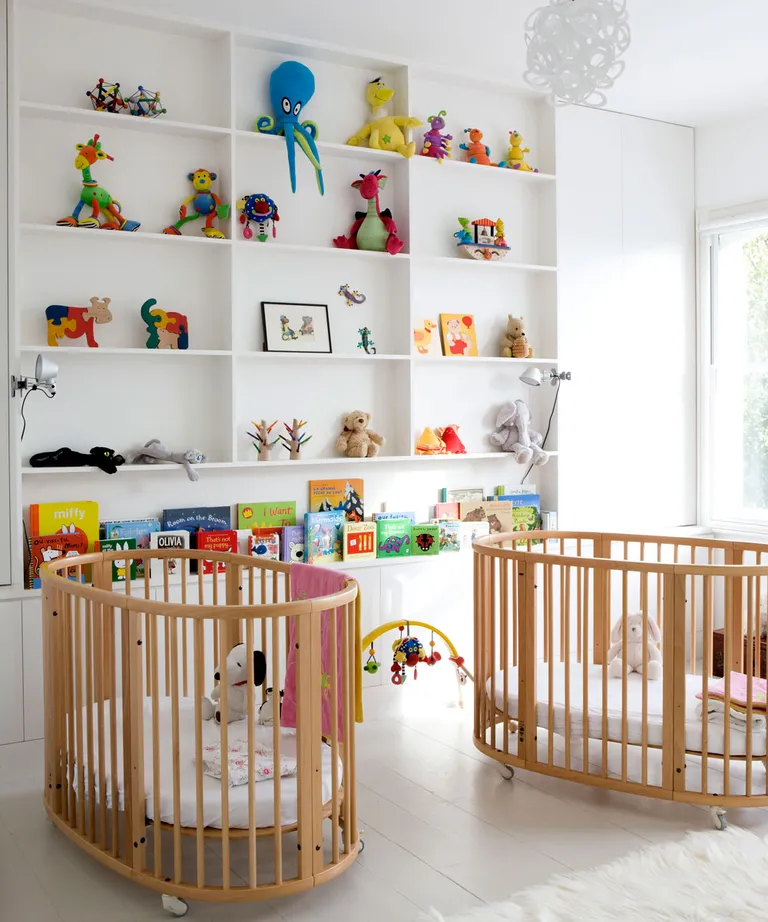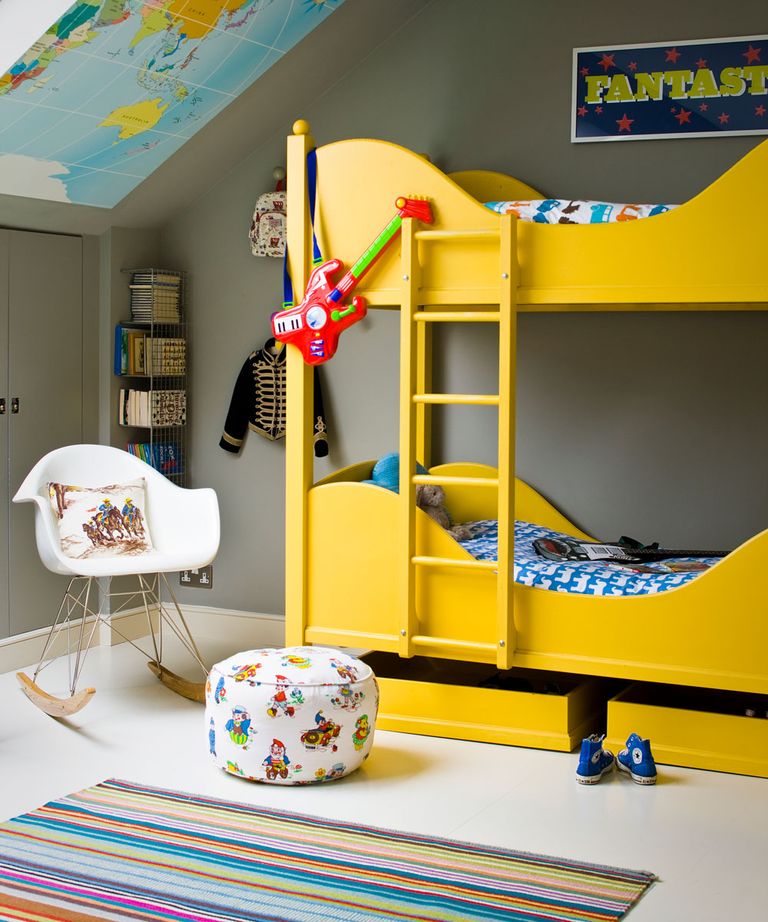How To Create Privacy In Shared Bedroom
We earn a commission for products purchased through some links in this article.
Shared bedrooms are becoming more common place among young families contending with small space living. Whether you have twins or siblings of different ages, sharing a bedroom from a young age can be a valuable life lesson – with children learning to share everything and learning to be patient. And while that's all good, dividing a shared room can help each child retain their own personal space within the room – which is hugely important for their personal development.
Shared bedroom ideas – diving a shared kids room
Shared sleeping quarters can quickly descend into cramped war zones. If you have two children who are chalk and cheese, fights and arguments can escalate quickly, even without the two living in close quarters. So when your kids are different sexes or different ages, dividing a room can prove challenging.
We've pulled together a few simple children's bedroom ideas for sharing, to help keep the peace and make sure both your kids feel represented in their shared room. We have tips for everything from maximising the most of the floor space to dividing the storage space equally between the two. Our thoughtful shared bedroom ideas show to divide a children's' bedroom idea with ease.
1. Put up diving walls for privacy

Image credit: B&Q
B&Q have the ultimate design solution for dividing a room for growing kids or different sexes! The genius room dividing panels are adjustable to suit all room heights, providing a quicker and cheaper solution than structurally altering a home with a growing family.
Each panel is made out of MDF. The height can be altered to fit any room using the adjustable feet with 4 non-slip pads. Ideal for a teenage girl and teenage boy's bedroom idea.
2. Cater for different ages in a small room

Image credit: Little Folks Furniture, Fargo High Sleeper with Small Double Bed
Not all siblings who share a room are of similar ages, so choosing a bed set up can prove tricky – especially when space is limited. This smart bunk bed design caters for a younger child with an elevated single bed, while providing a small double bed beneath for an older sibling. Space-saving and practical to suit very different ages.
3. Paint the walls with multiple colours

Image credit: Future PLC/ Colin Poole
If one child is begging for pink walls and the other wants a contrasting colour why not blend both their choices together, creating a colour scheme that keeps them both happy. Rather than painting each wall a different colour why not create a funky geometric design on the walls with the two colours?
Create this diagonal design by running masking tape down the wall to create a sharp line between the different coloured bedroom paint ideas. Finish off the room with room decorations that will appeal to both kids.
4. Divide the room with furniture placement

Image credit: Future PLC/ Colin Poole
Having a shared bedroom doesn't mean you can try to create a sense of personal space for each child. In this small kids bedroom idea the beds are placed on opposite sides of the room, to create more personal space for each child. The chimney breast has been cleverly utilised to give the illusion of a little privacy between the two bed. Anyone who has children fast approaching their teens will know the importance of privacy in a shared room.
5. Break up the conventional layout

Image credit: Little Folks Furniture
Don't feel like you have to conform with the traditions of having symmetry when it comes to where the furniture is placed. As this shared bedroom idea proves a different position for the bed can make a big impact on the rooms layout. Rather than seeking symmetry to zone the room for each child the beds are placed almost back to back to dominate one corner – freeing up the rest of the space for their individual needs.
Having the beds facing away from each other helps to give each child a different persecutive, a wall to call their own.
6. Mix and match individual styles

Image credit: Future PLC/ Paul Raeside
Your kids may have to share a room, but that's as far as it has to go. If you have one messy, one tidy, one boy, one girl, one explorer and one ballerina then fill the room with different room accessories and bedding. Although they're in the same room you can even go as far as giving them completely different beds and desks, don't deny them their own style just because they share the same room.
7. Coordinate the bedding

Image credit: Future PLC/ David Brittain
8. Welcome a feature wall for storage

Image credit: Future PLC/ Paul Raeside
Balance a twin set up with a feature wall for toy storage ideas and bookshelves. The curated wall provides plenty of space for double everything, from baby toys through to artwork and more grown-up accessories.
If you've had baby twins then why not keep them together? At a young age, it doesn't matter if they're different sexes they can happily share. Keep everything multicoloured in animal and alphabet designs which can be updated with pops of pink and blue if you wish.
9. Mismatch sheets and accessories to differentiate

Image credit: Future PLC/ Tim Young
If you've decided to use matching furniture throughout the room, a simple way of letting your kids show their personality in the room (and keep them separate in the wash) is to let them choose their own bedding. It is amazing the impact that coloured bedding can have on a room. If your kids have their heart set on a theme in the room, just make sure the bedding centres around it like in this nautical bedroom.
10. Add one harmonious accent colour

Image credit: California Shutters
Inject a hit of colour that both children like, to add a harmonious accent colour. A colour such as brilliant yellow will prove timeless as they grow, meaning you won't need to refresh every year as they grow out of baby pink or baby blue. Paint window shutter ideas in a striking yellow to invigorate the room and highlight the view beyond – encouraging them to look out to a world beyond those four walls.
11. Maximise floor space with bunk beds

Image credit: Future PLC/ Jeroen Van Der Spek
Bunk beds make the most out of the floor space, which is important when you have double the clothes, toys and personality in a room. It also means that siblings can operate in different spheres. You can now purchase bunkbeds that operate almost like completely separate rooms which is a life-saver for parents with kids that can't quite see eye to eye.
12. Include plenty of desk space for them to work in peace

Image credit: Future PLC
Siblings who share rooms have to sleep together, dress together and play together, so it is healthy to give them some space to themselves. Make sure to include choose a desk with plenty of space so they can complete there homework on their own without their sibling pestering them. This is especially important if there is an age gap between your children, if one is a teenager they need a space that they can leave there revision for any upcoming tests, safe in the knowing it won't be mistaken as waste paper by there younger brother or sister.
13. Personalise everything

Image credit: Future PLC
So you don't get into 'but that's mine' arguments, personalise everything where possible. Fun wall art, bedding embroidery and even painted signs above each of there beds are all great ways to show the divide in the room, whilst keeping everything else the same. In a shared room, you do run the risk of siblings feeling like they're unable to express themselves, but with personalisation they can literally stamp there name on everything.
14. Add extra privacy with a tent

Image credit: Future PLC/ Simon Whitmore
Every child loves a den but it is a clever addition to a shared bedroom. They can choose to play in the tent together or use it as a space to get away from each other. You can buy indoor children's tents online, or make one yourself that will fit perfectly into the corner of the room like this one.
This bedroom tent is as simple to create as hanging a sheet over a pole attached to the ceiling and securing it to two point son the wall. All that's left is to fill it with a cosy rugs and cushions.
15. Create storage for both bunk bed levels

Image credit: Future PLC/ David Brittain
The storage for traditional bunk beds is usually found on the bottom level under the bottom bunk. However, shared under bed storage, even if your two kids are best friends is just a recipe for disaster. Insert a peg rail next to the top and bottom bunk and hang storage baskets or bags over them like in this room. This will help keep your kids belongs separate and within easy reach from their bed, just be sure they are within easy reach for you to take down incase you're called in for any lost plimsoll emergencies.
16. Choose a bespoke bunk bed design for privacy

Image credit: Future PLC/ James French
Box bunks are a great way to utilise space – they are much like normal bunks, but provide a little den of personal space. Encourage kids to decorate the inside of their box in their own drawings, artwork and bedding designs whilst keeping everything outside of that space the same.
This bed is perfect for siblings with different tastes as the outside can be painted one colour, but the enclosed insides can be painted to match each Child's interests. The ledge also provides space for them to display their precious belongings and pictures.
17. Avoid fights with matching beds

Image credit: Future PLC/ Paul Raeside
While letting them choose their own bed and furniture works in a perfect world. Sometimes the only way to avoid a sibling fight is to keep everything the same. This usually works best if your children are twins, the same sex and into the same things. If they aren't make sure to use a neutral palette such as creams and greys. It makes decorating easy, buying easy and no one can fight over what's theirs if it's all the same – but we can't guarantee that will stop them.
How do I arrange a shared bedroom?
The key to arranging a shared bedroom is to make it fair. Give the children their own personal space within the shared room to ensure they each feel a sense of belonging.
How do you make a shared room fun?
The element of a shared room is fun for most young children; you've always got company and you get double the toys to play with. To make the room fun you could adopt a characterful theme so that the room feels like a real escapism from a standard kids bedroom, make the originality of it being shared a good thing – rather than a negative.
How do you split a small shared room?
Video Of The Week
The best way to split a small shared room is to seek smart furniture choices, such as bunk beds and stacked storage to utilise space. When space is at a premium it is key to make your furniture work harder, choosing multifunctional pieces to offer more potential. For instance a desk area below situated beneath an elevated sleeper bed immediately creates more space for work, rest and play.
room sharing dilemmas.
How To Create Privacy In Shared Bedroom
Source: https://www.idealhome.co.uk/childrens-room/childrens-room-ideas/shared-bedroom-ideas-232418
Posted by: yeltonthationothe.blogspot.com

0 Response to "How To Create Privacy In Shared Bedroom"
Post a Comment